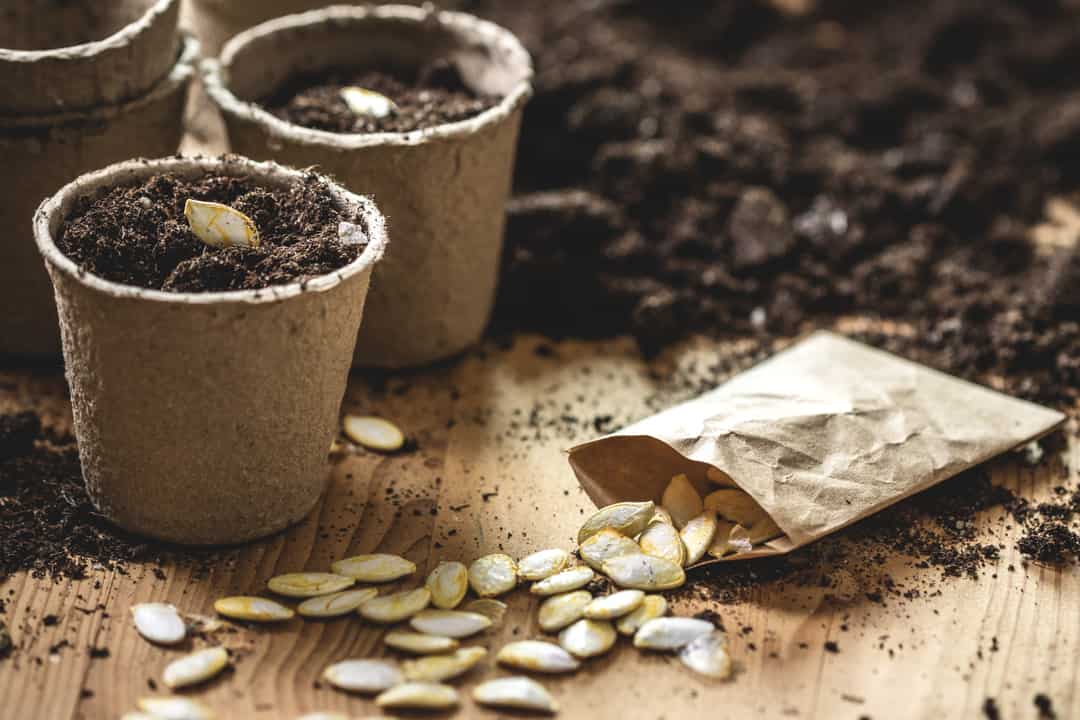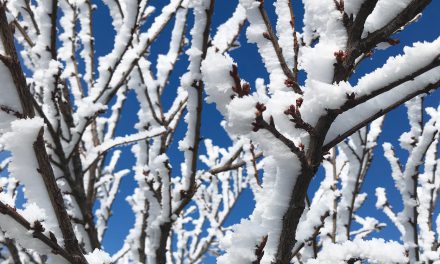The Herb Blurb
By Marisa Thompson

Talk about a rewarding bunch of plants to grow in New Mexico! Many herbs thrive in our climate, are easy to grow (even in containers, balconies, and windowsills), and can be harvested continually throughout the season. Parsley, rosemary, and chives are examples of a few with leaves that are particularly cold hardy and can be harvested in some gardens year-round. Because herbs grow quickly, you can be flexible with when and where you plant seeds or transplant seedlings.
I’m normally all about trees and tree care. Water scarcity and increasing temperatures scare me because even native, drought-tolerant trees require supplemental irrigation in our urban landscapes, and not just during establishment. The bigger a tree gets, the more water it requires. Like many local experts who love trees and are worried about their water needs, I’m pivoting my focus toward shrubs, ornamental grasses, and even herbaceous (nonwoody) annuals and perennials. Annuals are plants that complete their entire life cycle from seed to seed in a single year or less and tend to be killed by frost. Perennial plants can continue to grow year after year, either by forming new branches and leaves on woody stems or regrowing up from the roots each spring.
I grow several types of basil, mint, dill, oregano, chives, and parsley in containers alongside my patio each year. Containers dry out quickly, especially the small ones, so I paint the black grow pots lighter colors to reflect sunlight, cluster them together to shade each other, and add simple ollas to the soil (porous, unglazed terra cotta containers without drainage holes). Burying ollas lets me water quickly while the soil soaks up the water slowly. (For tips on using ollas and making them at home, visit my weekly gardening blog at nmsudesertblooms.blogspot.com and search for the term “olla.”)
To conserve water, I position the pots around landscape plants so that the water draining through can reach roots in the ground. This also reduces mess on the nonporous patio and eliminates pools of standing water in saucers. In the ground, I’ve had great luck with basil, fennel, parsley, rosemary, and sage. Mulching around the base with fibrous plant material can help hold moisture in the soil. Try old leaves, pine needles, woodchips, bark bits, or pecan shells. Thicker mulch layers are also wonderful for weed control.
The “Mediterranean” herbs—think marinara spices like basil, marjoram, oregano, rosemary, and thyme—are famous for growing well in sunny, dry, sandy sites. Good drainage is vital for many herbs. Lavender is famous for root rot when the soil stays moist too long. A common mistake is trying to amend clay soil and improve drainage by adding sand to the planting hole or gravel to the bottom of a container. These strategies may seem intuitive because water moves more quickly through rock than clay, but the laws of cohesion and adhesion are also at play: materials with relatively smaller pore spaces, like clay or even potting mix, hold more water than materials like sand or gravel with larger pore spaces. So in a sand-filled hole, water flows quickly through the sand at first, but then the soil underneath with smaller pores takes so long to absorb the water that it acts as a bowl, holding water in the sandy hole with the rotting roots. Eventually, as water soaks into the clay, the water is so tightly held in the tiny pore spaces that the sandy hole gets bone dry, but watering again from the top further exacerbates the bowl effect. Conversely, rocks at the bottom of a container do not help with drainage because after gravity pulls excess water down through the container holes, a bunch of water is still stuck in the smaller potting soil pores with nowhere to go. Water stagnates there, roots die back, and it becomes a perfect home for fungi and the fungus gnats that love them. Water has difficulty moving across the interface between different soil-type layers, and therefore so do roots. Solutions to soggy soils include 1) building a raised bed, 2) planting at the top of the side of a raised berm, or 3) using containers with potting mix. In clay soils, continue to water deeply (about two feet deep), just less frequently.
Herb gardening can be super economical, especially when comparing the huge and multiple harvests you can get from a single plant with the cost of just a few sprigs in the grocery store. Plus, when you have a mountain of basil leaves left over even after making pesto, you can treat herbs like a vegetable instead of a dainty garnish. Try this: Add a spoonful of hummus, chicken salad, baba ghanoush, or any favorite spread to a cracker and top it with a whole basil leaf, like a green umbrella on top.
Abundant harvests can be grown by herb gardening with minimal water and labor and no commercial fertilizer. The best tip I’ve ever heard about caring for herbs is to pinch them back frequently, even if you’re not planning to use the trimmings in the kitchen. By pinching a few inches off the tops, you’re removing the terminal buds, which encourages lateral branching and a bushier, fuller plant.
One more important thought: As Lynn Ellen Doxon points out in her book High Desert Yards & Gardens, it’s important to remember that supporting adult butterflies and moths means also supporting them during their younger, more voracious caterpillar phase. The black swallowtail butterfly spends its early days as a green caterpillar with black and yellow stripes that can strip a dill plant in no time. Instead of killing caterpillars on sight, consider plucking them from the plants you want to harvest from and placing them on nearby plants dedicated to the cause. Even the dreaded tomato hornworm metamorphosizes into the sphinx moth (aka hawk moth). Last year I brought a few potted ornamental chile pepper plants inside for decor, and my uncle pointed out a fat hornworm munching away at a tiny pepper. I moved her or him outside to do some much-needed pruning on a tomato plant that had gotten huge but wasn’t producing much fruit. I’m guessing that your herbs will be thriving so much you’ll have plenty to share with a young pollinator friend. If you’re not convinced, try planting a few extras just in case.

Additional resources
For specifics on growing dozens of herbs in New Mexico, find the New Mexico State University Extension Guide H-221, “Spices and Herbs for the Home Garden,” at aces.nmsu.edu/pubs/_h/H221; local research results on lavender and medicinal herbs at alcaldesc.nmsu.edu/herbs.html; and links to two Ready, Set, GROW! gardening webinars, one from October 2020 titled “The Humble Herb” and the other (upcoming in July) titled “Medicinal Plants,” at desertblooms.nmsu.edu/ready-set-grow.html.
Edible celebrates New Mexico's food culture, season by season. We believe that knowing where our food comes from is a powerful thing. With our high-quality, aesthetically pleasing and informative publication, we inspire readers to support and celebrate the growers, producers, chefs, beverage and food artisans, and other food professionals in our community.












